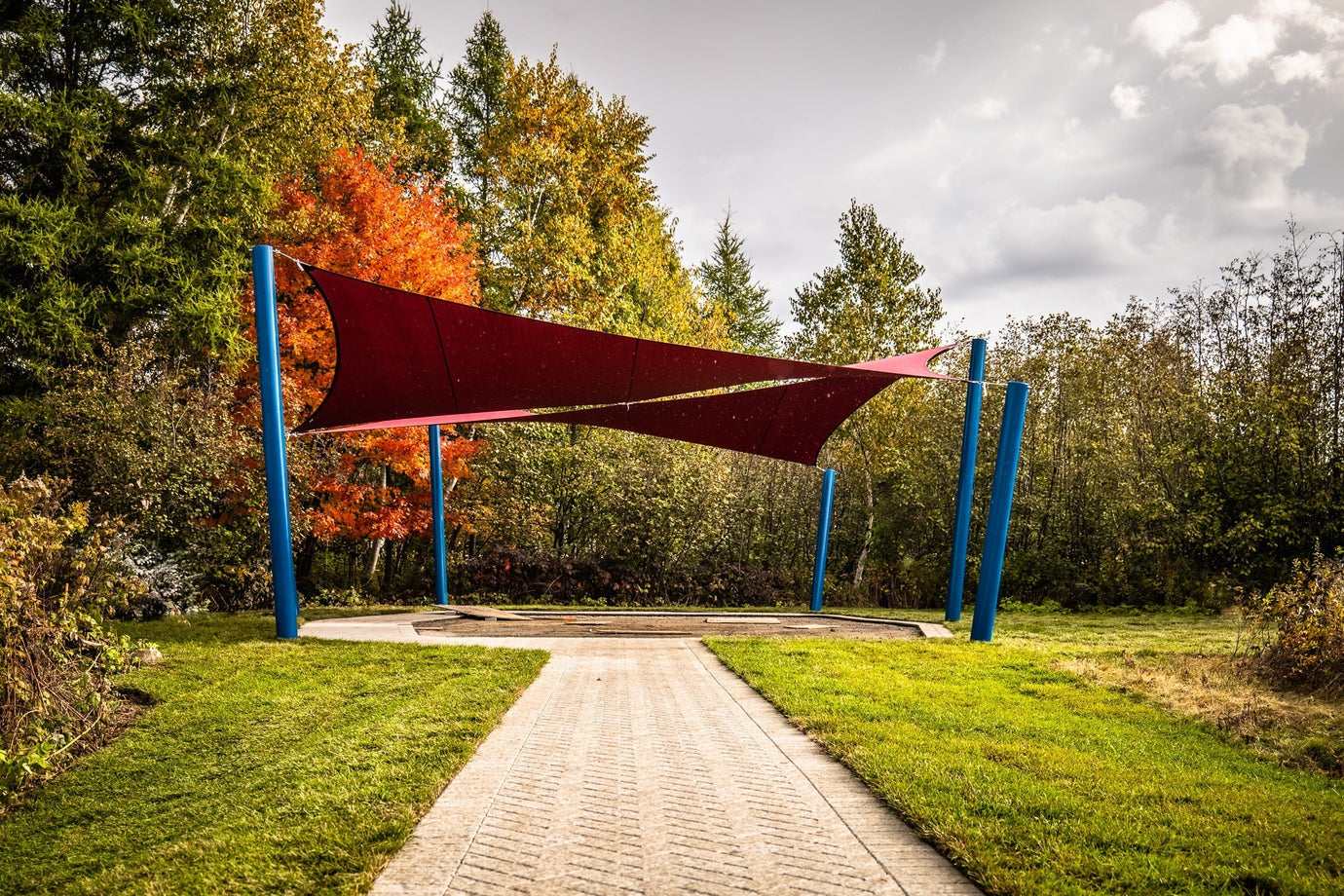Our YouTube channel includes detailed installation guides, frequently asked questions, product overviews and lots more. We are always open to content ideas so please let us know if there is a topic you would like us to cover.
How tight should my shade sail be?

Shade sails are a practical and attractive way to add shade to patios, decks, and other outdoor areas. They offer protection from the sun while enhancing the look of your space. But once you've selected the right sail, one of the most important steps is getting the tension right. Proper shade sails tensioning is essential for performance, stability, and long-term durability. In this guide, we’ll explain how to tension your sail correctly, avoid common mistakes, and maintain a secure, professional-looking installation.
Understanding the Importance of Tensioning
Correct shade sails tensioning is essential for both function and longevity. When a sail is properly tensioned, the fabric stays tight and smooth, preventing sagging that can lead to water pooling or flapping in the wind. Taut sails are also better equipped to resist wear and tear caused by constant movement or pressure on anchor points.
Over time, exposure to sun, rain, and temperature changes can cause the fabric to stretch slightly, reducing tension. That’s why it’s important to check the sail regularly and adjust as needed. Keeping your shade sail well-tensioned not only improves its performance but also helps extend its usable life.
Step-by-Step Guide to Tensioning Your Shade Sail
1. Assess the Installation Area
Before installing your shade sail, take time to assess the layout of your space. Look for obstacles such as tree branches, power lines, or nearby structures that could interfere with the sail when it's fully tensioned. The size and shape of the area will determine which sail shape and layout are most suitable.
2. Select the Right Tensioning Hardware
Choosing the correct hardware is essential for safe and effective shade sails tensioning. Common options include turnbuckles, D-shackles, and snap hooks—ideally made from stainless steel for rust resistance. Make sure each component is rated for the load your sail will carry, especially if the sail spans a large area or will be exposed to frequent wind.
3. Install Secure Anchor Points
Anchor points are the foundation of your tensioning setup. These can include structural walls, wood or metal posts, or even solid trees in some cases. For posts, use galvanized steel or pressure-treated wood, and embed them deep enough to handle long-term stress. Position anchor points to allow a slight angle for proper drainage and maintain an even distribution of tension across the sail.
4. Attach the Shade Sail
Once your anchor points and hardware are installed, attach each corner of the sail using snap hooks or shackles. Start with a loose connection at all points—this gives you flexibility to adjust the tension gradually and evenly during the final steps.
5. Tension the Sail Gradually
Using turnbuckles, begin to tighten the sail at each corner in small, equal increments. Proper shade sail tensioning should leave the fabric firm and wrinkle-free, but not overstretched. The goal is to eliminate sagging and promote water runoff, while allowing the sail to flex slightly during windy conditions. Over-tightening can stress the hardware or fabric, so take care to find a balanced tension.

Common Mistakes and How to Avoid Them
Over-Tensioning the Sail
Applying too much tension is a frequent mistake. While a firm sail is essential, over-tightening can stress both the fabric and hardware. This often leads to premature wear, fabric stretching, or even anchor point failure. To avoid this, always follow the sail manufacturer’s recommended tensioning guidelines and adjust gradually rather than forcefully.
Poor Anchor Point Installation
Even with proper tensioning, your setup will only perform well if the anchor points are secure. Posts should be deeply embedded and ideally set in concrete to resist movement. When fixing to walls or other structures, make sure the surface and hardware are strong enough to bear continuous load without shifting or cracking.
Overlooking Environmental Conditions
Ignoring your local climate can reduce the effectiveness and safety of your sail. Windy conditions, heavy rain, and winter snow loads all put extra stress on the fabric and frame. During storms or extreme weather, it’s best to temporarily remove the sail to prevent damage. Factoring in environmental pressure when tensioning also helps extend the life of your system.
Maintaining Tension: Care and Seasonal Adjustments
Regular Inspections
Check your shade sail periodically for signs of wear, such as frayed edges, fading, or loose stitching. Inspect all hardware for rust, corrosion, or movement at anchor points. Replacing worn or weakened components early can prevent bigger failures and help maintain proper tension across the sail.
Cleaning the Shade Sail
To keep your sail performing well, clean it every few months with mild soap and water. Remove dirt, pollen, or debris with a soft brush or cloth, and avoid using bleach or abrasive cleaners, which can weaken the fabric. Always let the sail dry completely before tightening or re-tensioning to avoid trapping moisture.
Seasonal Tension Adjustments
Changing weather calls for changes in how your sail is tensioned. In the warmer months, slightly increased tension helps the fabric handle water runoff from sudden rain. In colder climates, a looser setup—or even temporary removal—is often best to prevent stress from snow accumulation. Adjusting the tension to match seasonal demands helps preserve the fabric and extend the life of your system.
Exploring Advanced Techniques
Using a Shade Sail with a Retractable System
If you need more flexibility in your outdoor setup, a retractable shade sail system could be the right solution. These systems allow you to extend or retract the sail depending on weather conditions or time of day. Although they require more complex installation and hardware, retractable systems give you better control over shade and airflow, while still maintaining proper shade sails tensioning when deployed.
Integrating Shade Sails into Outdoor Design
Shade sails don’t just offer protection—they can be a key part of your landscape design. Try combining multiple sails in various colors, sizes, or shapes to create a layered look. This approach adds visual interest and can improve coverage, especially in large or irregularly shaped areas. Proper tensioning remains essential to keep each sail in place and maintain clean lines that complement the overall design.

FAQ: Shade Sails Tensioning
Can I tension a shade sail by hand without tools?
While you can make minor adjustments by hand, proper tensioning usually requires tools like turnbuckles or a ratchet system. These tools help apply consistent force across all corners, which is difficult to achieve manually and may lead to uneven results.
How can I tell if my shade sail is too loose or too tight?
A properly tensioned sail will appear smooth and wrinkle-free, with minimal movement in wind. If the fabric sags or flaps, it’s likely too loose. If corners or edges show signs of stress or pulling, it may be overtightened and at risk of damage.
Are triangle or rectangle shade sails easier to tension?
Triangular sails are generally easier to tension evenly due to having only three corners. Rectangular or square sails can require more precise anchor placement and adjustment to maintain even tension without causing sagging or twisting.
Conclusion
Installing a shade sail is a smart way to improve both the comfort and appearance of your outdoor space. But to get the most from your investment, shade sails tensioning is essential. A properly tensioned sail resists sagging, stands up to changing weather, and maintains a sleek, professional appearance over time.
By following key steps—like choosing the right hardware, securing reliable anchor points, and adjusting tension seasonally—you’ll improve both the performance and longevity of your shade sail. Whether you're a DIY enthusiast or working with a professional, mastering shade sails tensioning ensures your installation is built to last and ready to perform in all conditions.



